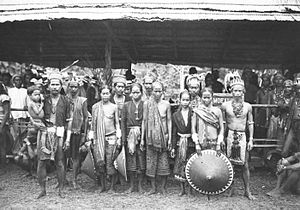

You can help expand this article with text translated from the corresponding article in Indonesian. (November 2014) Click [show] for important translation instructions.
Content in this edit is translated from the existing Indonesian Wikipedia article at [[:id:Suku Dayak Mualang]]; see its history for attribution.{{Translated|id|Suku Dayak Mualang}} to the talk page. |

A group of Mualang Dayaks during a visit to Governor-General J.P. Graaf of Limburg StiruminBorneo, circa 1920.
| |
| Total population | |
|---|---|
| 44,400[1] | |
| Regions with significant populations | |
| Languages | |
| Mualang language, Indonesian language | |
| Religion | |
| Kaharingan (predominantly), Christianity | |
| Related ethnic groups | |
| Iban people |
Mualang (also MoealangorDayak Mualang) are an indigenous people of West Kalimantan from the Dayak group and a sub-ethnic of the Iban people.[2] They speak the Mualang language and they are mostly concentrated in areas in the Sekadau Regency and Sintang RegencyofWest Kalimantan, Indonesia. The specific districts where the Mualang people live include:
The Mualang language belongs to the Ibanic languages branch along with other Ibanic dialects such as Kantuk, Bugao, Desa, Seberuang, Ketungau and Sebaruk.[3] These dialects mainly differ from one another in their pronunciations of specific phonemes. For example, words that end with "i" can be pronounced as "e" or "y" where "kediri" becomes "kedire", "rari" becomes "rare", "inai" becomes "inay", and "pulai" becomes "pulay". These words still carry the same meaning even though they are pronounced differently. These dialects also have some lexical variation between them.


|
| |
|---|---|
| Sumatra |
|
| Java |
|
| Kalimantan |
|
| Sulawesi |
|
| Papua |
|
| Lesser Sunda Islands |
|
| Maluku Islands |
|
| Non-indigenous |
|
This Indonesia-related article is a stub. You can help Wikipedia by expanding it. |
This article about an ethnic group in Asia is a stub. You can help Wikipedia by expanding it. |